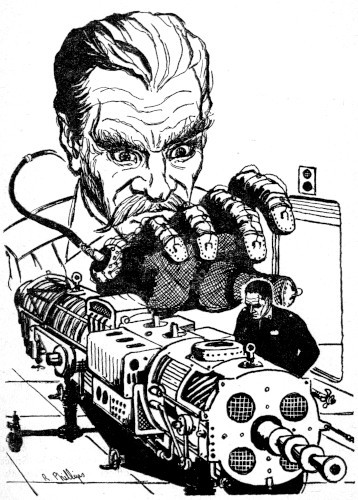Stroke of Genius
by RANDALL GARRETT
Illustrated by PHILLIPS
Crayley plotted a murder that was
scientific in both motive and method—and
as perfect as the mask of his face!
[Transcriber's Note: This etext was produced from
Infinity Science Fiction, August 1956.
Extensive research did not uncover any evidence that
the U.S. copyright on this publication was renewed.]

Crayley stood thoughtfully before the huge screen and watched thefingers move.
Metal fingers, five on each hand; each hand attached to an arm, andeach pair of arms connected to a silvery sphere that sat atop afour-foot pillar. Within the pillar, micro-relays ticked and chuckled,sending delicately measured surges of power here and there throughsilver nerves to metal muscles. Responding, the hands built an energygenerator. And when they finished, they built another. And another. Onand on, monotonously.
Crayley rubbed absently at his mustache and plotted murder.
"—be a great deal cheaper, Mr. Crayley?"
Crayley realized he hadn't been listening to what the man beside himwas saying. He turned his head to look at the Space Force officer andsaid quietly, "I'm sorry, major; I didn't quite get you."
"I said that it seems to me that ordinary production machinery would bea great deal cheaper. Why do they use those waldoes?"
Crayley smiled faintly. "Why do you use waldoes to repair a generatoron a ship?"
The major looked at Crayley to see if he was kidding, then said, "A mancan't live five seconds near an unshielded generator, and you have totake the shielding off to get at the innards. But I don't see how thatapplies. Each repair job is different. I'll admit that I'm not a driveengineer—I wouldn't know the first thing about repairing one—but I doknow that the engineer has to use remote control hands because the workis so delicate.
"But this—" He waved a hand at the screen. "—is recorded. It'sroutine. Why spend all the money on those tape-controlled robots whenmuch simpler machines can be made to do the job?"
I wonder, Crayley thought to himself, if this blockhead knows whichend of his ship to point up when he's taking off? "Two reasons, Major.In the first place, building a sub-nucleonic converter is also adelicate job—as delicate as repairing it. In the second place, we havesomething here that will save money in the long run. Do you know whatre-tooling would cost in this business if we used ordinary bit-by-bitproduction line methods?"
The major spread his hands. "I have no idea."
"Millions. Every day, some physicist comes up with a new idea onsub-nucleonics. Within a week or so, enough of these ideas havesnowballed to produce a slight modification that will improve aspacedrive—increase its speed, improve its efficiency, and so on.Within six or eight months, enough improvements have built up to makeit worthwhile to incorporate them into the drive we're building. IfNorth American used production line robots, we'd have to rip out thewhole bunch and rebuild 'em to make the new generator. Why? Because theordinary robotic device is a specialist; it can, at most, do two orthree things—usually only one. And if you eliminate the thing that aparticular robot does, or change it a little, you have to rebuild thetools and re-arrange them before reprogramming the whole line.
"The waldo, a working replica of the human arm and hand, isn'tspecialized like that; it's adaptable; it can do anything. If we haveto modify the design, all we have to do is reprogram the tapes,